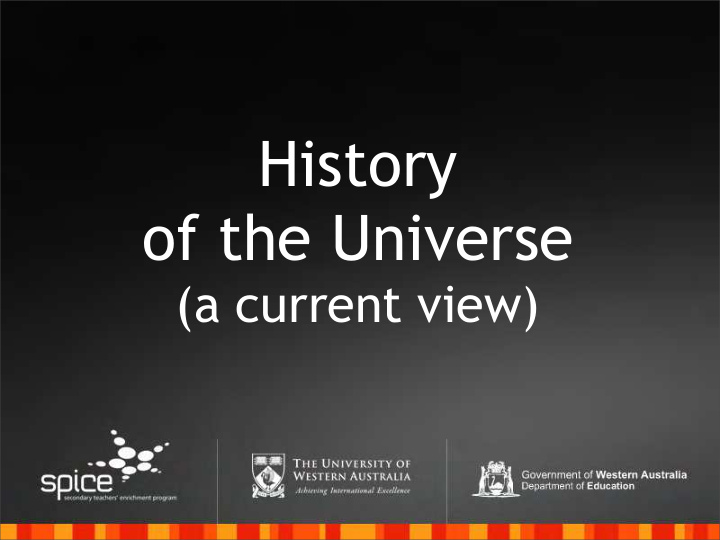



History of the Universe (a current view)
The Big Bang theory • Discoveries in astronomy and physics suggest that the Universe had a definite beginning. • The Big Bang theory is the prevailing theory that describes the origin and evolution of the Universe. • It is considered to be our best theory of cosmology because it explains most experimental observations. ‘360-degree Panorama of the Southern Sky’ by European Southern Observatory. CC-BY-3.0, commons.wikimedia.org/wiki/ 2 File:360-degree_Panorama_of_the_Southern_Sky_edit.jpg
What was the Big Bang? • About 13.7 billion years ago, the entire Universe was compressed into a singularity – a place with zero volume and infinite density. • Matter, energy, space and time all began inside the singularity. • At the moment of the Big Bang, the Universe started to expand, cool and become less dense. • The Universe is still expanding today. 3
What the Big Bang wasn't • The Big Bang wasn't an explosion that happened somewhere in space. • The Universe didn't appear somewhere in space. • The Big Bang created space and time. 4
What is an expanding Universe? • Galaxies move apart because space itself is expanding. • They are not moving apart because of some past explosion. 5
What is an expanding Universe? • Galaxies move apart because space itself is expanding. • They are not moving apart because of some past explosion. 5
Expansion of the Universe Galaxies move apart as the Universe expands. 6
The beginning of the Universe • Big Bang theory doesn't attempt to explain why the Universe was created, or what (if anything) might have existed before it. • Our ideas about the very early Universe are, at best, speculative. • The first 10 -43 seconds of the Universe is called the Planck era. Conditions were so extreme that we suspect quantum behaviour was dominant, including quantum gravity. • We don't yet have a theory of quantum gravity, but we do have theories that explain what happened from this time on. 7
Fundamental interactions • All forces in the Universe can be attributed to four fundamental interactions between particles. • Physicists believe that all known interactions were unified at the moment of the Big Bang. • Shortly after the Big Bang, this unified interaction began to separate into gravitational, strong, weak and electromagnetic interactions. 8
Fundamental interactions 10 32 K • 10 -43 seconds after the Big Bang, gravity separated from the unified interaction. 9
Fundamental interactions • 10 -35 seconds after the Big Bang, the strong interaction separated. 10 27 K • This released a vast amount of energy, making the Universe expand at an extraordinary rate. 10
Fundamental interactions • 10 -12 seconds after the Big Bang, the electromagnetic and the weak interactions separated. The four fundamental interactions were now distinct, as they remain to this day. 10 15 K 11
The evolution of matter quark era 10 -12 – 10 -6 seconds after the Big Bang hadron era 10 -6 – 1 second after the Big Bang lepton era 1 sec – 10 seconds after the Big Bang radiation era 10 sec – 300 000 years after the Big Bang 12
The quark era (10 -12 – 10 -6 s) • When the strong interaction separated from the unified interaction, matter separated into quarks and leptons. • Quarks 'feel' the strong interaction , but leptons don't. • The temperature of the Universe was too high for quarks to combine. 13
Recommend
More recommend